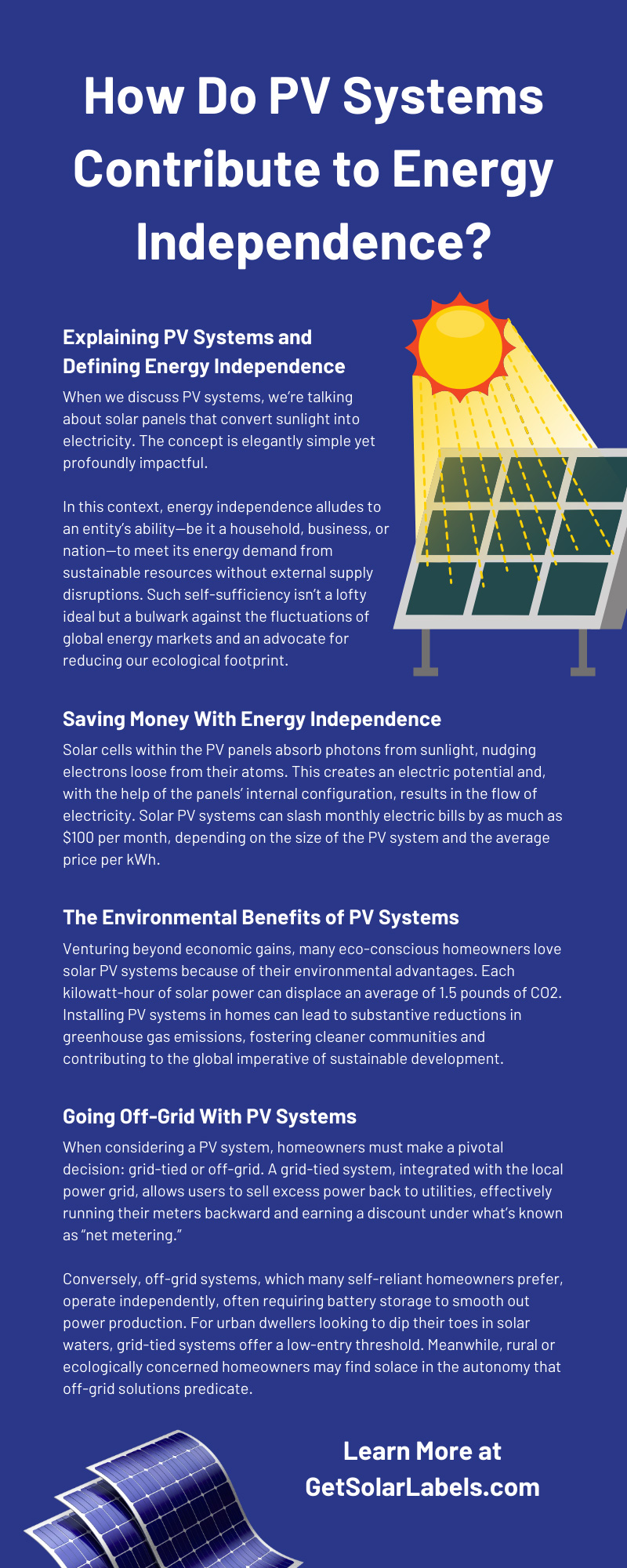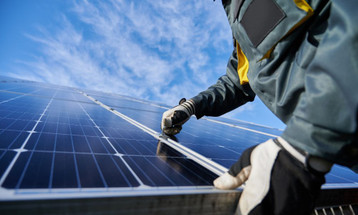Apr 22nd 2024
How Do PV Systems Contribute to Energy Independence?
More and more homeowners prioritize energy independence for various reasons, whether their aim is promoting a sustainable lifestyle or being better prepared for emergencies. In the quest for energy independence, solar photovoltaic (PV) systems are revolutionizing the very nature of power, making it accessible, sustainable, and, most importantly, renewable. In our solar guide below, we’ll explain how PV systems contribute to energy independence, debunk common misconceptions, and show you how a PV system can make you energy independent.
Explaining PV Systems and Defining Energy Independence
When we discuss PV systems, we’re talking about solar panels that convert sunlight into electricity. The concept is elegantly simple yet profoundly impactful.
In this context, energy independence alludes to an entity’s ability—be it a household, business, or nation—to meet its energy demand from sustainable resources without external supply disruptions. Such self-sufficiency isn’t a lofty ideal but a bulwark against the fluctuations of global energy markets and an advocate for reducing our ecological footprint.
Saving Money With Energy Independence
The beauty of a PV system lies not just in the power it captures but in the dollars it saves. Every homeowner feels the pain of unending monthly utility bills that only seem to get more expensive, and PV systems can help significantly reduce these energy bills.
Solar cells within the PV panels absorb photons from sunlight, nudging electrons loose from their atoms. This creates an electric potential and, with the help of the panels’ internal configuration, results in the flow of electricity. Solar PV systems can slash monthly electric bills by as much as $100 per month, depending on the size of the PV system and the average price per kWh.
The Environmental Benefits of PV Systems
Venturing beyond economic gains, many eco-conscious homeowners love solar PV systems because of their environmental advantages. Each kilowatt-hour of solar power can displace an average of 1.5 pounds of CO2. Installing PV systems in homes can lead to substantive reductions in greenhouse gas emissions, fostering cleaner communities and contributing to the global imperative of sustainable development.
The impact isn’t just numerical. Those with solar PV systems also earn immense pride that their home is helping the environment instead of harming it.
Going Off-Grid With PV Systems
When considering a PV system, homeowners must make a pivotal decision: grid-tied or off-grid. A grid-tied system, integrated with the local power grid, allows users to sell excess power back to utilities, effectively running their meters backward and earning a discount under what’s known as “net metering.”
Conversely, off-grid systems, which many self-reliant homeowners prefer, operate independently, often requiring battery storage to smooth out power production. For urban dwellers looking to dip their toes in solar waters, grid-tied systems offer a low-entry threshold. Meanwhile, rural or ecologically concerned homeowners may find solace in the autonomy that off-grid solutions predicate.
Debunking Common Misconceptions of Solar PV Systems
The shift to PV isn’t devoid of hesitations, and rightly so. The investment is substantial, concerns about reliability or aesthetics linger, and the occasional headwind of misinformation can give pause. However, the industry has pivoted significantly, answering these concerns with technological feats and financial instruments.
For example, the durability of modern panels is now a testament to their longevity, with warranties often stretching over three decades. And while some homeowners may scoff at the look of the panels on their finely crafted homes, solar PV systems now offer sleek designs and even transparent options.
How To Become Energy Independent With a Solar PV System
If you want to turn your home into a beacon of self-sufficiency, allow us to help! Here is a practical guide to this transformational process, from the first spark of interest to the moment your meters thump to the rhythm of solar cycles.
Self-Assessment
Start by gauging your home’s energy consumption, your geographical setting’s solar potential, and the local regulations and incentives that might affect your potential PV system. This information will help determine the size of your PV system and its costs.
Financial Footing
Understand the costs involved and the many financing options that can make this green endeavor fiscally sound. PV systems require a lot of upfront costs but with a long-term payoff, so ensure your financial health is ready for this burden.
System Sizing
PV systems don’t all come in the same size. In fact, you can customize a system to fit your home ideally. Work with solar professionals to determine the right system size based on your energy needs and available roof space.
Permit Phase
Every PV system must meet certain safety requirements for approval from local authorities, including sufficient solar placards and a sound structural plan for installation.
Installation
With the plan approved and permits in hand, it’s time to install the panels physically. Installation can be expensive, but the Federal Tax Credit for Solar Photovoltaics will offer a 30 percent tax credit toward installation costs to ease the burden.
Connection
If grid-tied, an installer must connect and synchronize your system. Your installer will handle this, and you’ll receive notice when the utility company connects your panels to the grid.
Maintenance
Regular checks and occasional tune-ups are par for the course with PV systems. Engage in a relationship with your solar provider to ensure your system’s health is as robust as its initial installation promised.
The Future of PV Systems and Energy Independence
Innovation spurs the trajectory of PV systems forward. Technological advancements are seeing the emergence of solar shingles, bifacial panels, and transparent solar options that promise to blur the line between function and form.
Furthermore, the federal and state governments are passing legislation to support renewable energy, such as net metering laws, tax incentives, and grants, to incentivize more to adopt renewable solar energy. The future looks bright, not just because the sun isn’t going anywhere—at least, not for another five billion years.
Conclusion
The dawn of the solar era is upon us, beckoning a future illuminated by the promise of energy independence, environmental stewardship, and economic liberation. Now, you should better understand how PV systems can contribute to your energy and financial independence from costly utility bills.
If you’re ready to start your solar journey, Get Solar Labels is here to help. Our inventory includes all the necessary safety and warning labels and placards PV systems need to ensure safety and efficiency. Don’t install your PV system without high-quality labels from Get Solar Labels.


